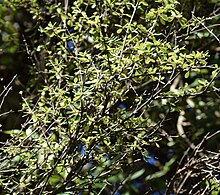Meterana grandiosa
| Meterana grandiosa | |
|---|---|

| |
| Female | |

| |
| Male | |
| Scientific classification | |
| Domain: | Eukaryota |
| Kingdom: | Animalia |
| Phylum: | Arthropoda |
| Class: | Insecta |
| Order: | Lepidoptera |
| Superfamily: | Noctuoidea |
| Family: | Noctuidae |
| Genus: | Meterana |
| Species: | M. grandiosa
|
| Binomial name | |
| Meterana grandiosa | |
| Synonyms[2] | |
| |
Meterana grandiosa is a species of moth in the family Noctuidae. This species is endemic to New Zealand. It is classified as "At Risk, Relict'" by the Department of Conservation.
Taxonomy
[edit]This species was first described and illustrated by Alfred Philpott in 1903 and was given the name Melanchra grandiosa.[1] Philpott used a female specimen he collected at West Plains in Southland in May.[3] George Hudson discussed and illustrated this species in his 1928 book The Butterflies and Moths of New Zealand.[4] In 1988 John S. Dugdale placed this species within the genus Meterana.[2] The holotype specimen is held at the New Zealand Arthropod Collection.[2]
Description
[edit]Larvae are green in appearance with a broad white lateral stripe.[5] As they mature larvae turn a pinkish colour and can grow to be 3.3 cm in length.[5]
Philpott originally described the adult female of the species as follows:
♀︎, 44 mm. Antennae and legs brownish-ochreous. Palpi brown, terminal joint ochreous. Face greyish. Thorax bright orange-brown, between patagia brownish-yellow; slight anterior and strong double posterior crest. Abdomen dull-brownish, anal segment tipped with pale-yellow. Fore wings slightly sinuate on costa, apex subacute, termen crenulate, purplish-brown, base suffused with ochreous. An indistinct pale irregular line near base; a small elongate yellow spot above middle at about 1⁄5; an ochreous patch below middle from base to 1⁄5; below this a broad elbowed black line to 1⁄4; dorsum broadly suffused with pale-ochreous; an irregular V-sbaped pale purplish-brown line from near costa at about 1⁄4;, shortly bent towards base, thence obliquely to near dorsum at 1⁄2, again slanting upwards to reniform; space within V-shaped line much darker. Near centre of wing, above middle, a large bell-shaped ochreous blotch, the base towards costa. Eeniform faintly outlined in pale purplish-grey. A sharply defined oblique line from costa near apex to dorsum at 2⁄3, dentate near apex and broadly projecting below middle; beyond this line the colour is ochreous-brownish densely irrorated with dark- brown. A waved subterminal line. Cilia brownish-ochreous on termen, pale-ochreous on dorsum. Hind wings dull brownish; cilia brown, greyish towards tornus.[3]
Distribution
[edit]This species is endemic to New Zealand.[6] M. grandiosa has occurred in Wairarapa, Central Otago, Otago Lakes, Dunedin and Southland zones.[7][5] However this species is now locally extinct in its type locality of West Plains and has not been collected in Dunedin since the 1960s.[7]
Life cycle and behaviour
[edit]Larvae hide underneath the bark of their host plants during the day which makes them difficult to detect.[7] Larvae pupate between November and December and the adult moth emerges during the autumn months of mid April to early June.[7]
Host species and habitat
[edit]
The plant host species for the larvae of M. grandiosa are small-leaved Olearia species.[7][5] These include O. hectorii and O. odorata.[7]
Conservation status
[edit]This moth is classified under the New Zealand Threat Classification system as being "At Risk, Relict".[8] One of the reasons for this classification is that the habitat of this species is under threat from land development.[7] The elimination of the host plants of this species has resulted in their extinction from sites in New Zealand.[5]
References
[edit]- ^ a b "Meterana grandiosa (Philpott, 1903)". www.nzor.org.nz. Landcare Research New Zealand Ltd. Retrieved 2018-05-17.
- ^ a b c Dugdale, J. S. (1988). "Lepidoptera-annotated catalogue, and keys to family-group taxa" (PDF). Fauna of New Zealand. 14: 207 – via Landcare Research New Zealand Ltd.
- ^ a b Philpott, Alfred (1903). "On some new species of Lepidoptera (moths) from Southland". Transactions and Proceedings of the New Zealand Institute. 35: 246–249 – via Biodiversity Heritage Library.
- ^ Hudson, G. V. (1928). The Butterflies and Moths of New Zealand. Wellington: Ferguson & Osborn Ltd. p. 64.
- ^ a b c d e Patrick, Brian (2000). Lepidoptera of small-leaved divaricating Olearia in New Zealand and their conservation priority (PDF). Wellington, N.Z.: Department of Conservation, New Zealand. ISBN 0478220154. OCLC 48661253.
- ^ Gordon, Dennis P., ed. (2010). New Zealand inventory of biodiversity: Kingdom animalia: chaetognatha, ecdysozoa, ichnofossils. Vol. 2. p. 461. ISBN 978-1-877257-93-3. OCLC 973607714. OL 25288394M. Wikidata Q45922947.
- ^ a b c d e f g Patrick, Brian; Dugdale, John S. (2000). Conservation status of the New Zealand lepidoptera (PDF). Wellington, N.Z.: Department of Conservation, New Zealand. p. 32. ISBN 0478218672. OCLC 154670803.
- ^ Hoare, R.J.B.; Dugdale, J.S.; Edwards, E.D.; Gibbs, G.W.; Patrick, B.H.; Hitchmough, R.A.; Rolfe, J.R. (2017). Conservation status of New Zealand butterflies and moths (Lepidoptera), 2015 (PDF). Wellington, New Zealand: New Zealand Department of Conservation. p. 8. ISBN 9781988514383.

